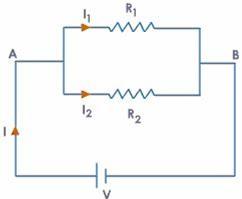CURRENT ELECTRICITY
Current electricity is the rate at which an electricity source will make charges to flow or pass a certain point in a conductor or in an electric circuit.
This means that, when electrical devices Electric current is the rate of charge flow past a given point in an electric circuit, measured in Coulombs/second which is named Amperes. In most DC electric circuits, it can be assumed that the resistance to current flow is a constant so that the current in the circuit is related to voltage and resistance by Ohm's law. The standard abbreviations for the units are 1 A = 1C/s.
COMBINATION OF RESISTORS
Resistors can be connected either in series or parallel depending on the magnitude of effective resistance required. Series connection gives a bigger value of effective resistance and the parallel connection gives small value of effective resistance.
RESISTORS IN SERIES
By connecting resistors in series, when the switch 'S' is closed, the current 'I' which flows through the circuit flows through each resistor.

Total resistance between points A and B which is commonly referred to as equivalent resistance (Req) will produce a potential difference in the circuit given by ohm’s law as;
V=IReq
The voltage across each resistor in the circuit is given by V1 =IR1 and V2 =IR2
The sum of the voltage drops equal to the potential difference in the circuit (i.e. potential difference between (A and B)
Total voltage = V1 + V2
... VT = V1 + V2
Total voltage = V1 + V2
Since V = IR, V1 = IR1 and V2 = IR2
IRT = IR1 + IR2
IRT =I (R1 + R2 )
RT = R1 + R2
RESISTORS IN PARALLEL
RESISTORS IN PARALLEL
In the figure below I is the current in the main circuit. On the other hand I1 and I2 are current through individual resistors R1 and R2.
The sum of all currents through the resistors which are connected in parallel gives the value of current equal to the main circuit.
 .
.
Therefore, IT = I1 + I2
If RT is the equivalent resistance of the main circuit between A and B, then by Ohm’s law the current is given by;
From IT = I1 + I2

On diving both sides by V
On diving both sides by V
Cross multiplication
1(R1R2) = RT (R1 + R2)

For two resistors connected in parallel.
EXAMPLES
1.Given that R1= 4Ω and R2= 6Ω, find the equivalent resistance when the resistors are connected.
1.Given that R1= 4Ω and R2= 6Ω, find the equivalent resistance when the resistors are connected.
- In parallel
2. In series
Solution
1.Series
Solution
1.Series
RT = R1+R2
RT = 4Ω + 6Ω
RT = 10Ω
2.Parallel
2.Parallel
= 2.4Ω
2.Two conductors of resistance 4Ω and 5Ω are connected in series across a 60V supply. Find;
2.Two conductors of resistance 4Ω and 5Ω are connected in series across a 60V supply. Find;
- The total resistance
- The current in the circuit
- The potential difference across each resistor
RT = R1+R2
= 4Ω + 5Ω
= 9Ω
the total resistance = 9Ω

the total resistance = 9Ω
I = 6.7A
Potential difference across R1
Potential difference across R1
V1 = IR1
V1 = 6.7 x 4 = 26.8v
Potential difference across R2
V2 = IR2
V2 = 6.7 x 5 = 33.5v
Total current = 26.8 + 33.5 = 60A
3.Consider the circuit shown below. What will be the reading on the Ammeter?
Solution
V = 12V
RT =2Ω
I = 6A
EXERCISE
1. In a circuit, the amount of charges passing through a point is 9 coulombs in 4.5 seconds. What is the electric current passing at that point?
1. In a circuit, the amount of charges passing through a point is 9 coulombs in 4.5 seconds. What is the electric current passing at that point?
Solution
Quantity of charges = 9 coulombs
Time = 4.5 sec
Electric current =?

Electric current = 2coulombs/sec
2. The two resistances 15Ω and 5Ω are connected in series across 20v supply, find;
2. The two resistances 15Ω and 5Ω are connected in series across 20v supply, find;
- Total resistance
- The total current in the circuit
- The current through each resistor
Solution
Data given
R1 = 15Ω
R2 = 5Ω
Voltage = 20v
The total resistance
The total resistance
RT = R1 + R2
= 15Ω + 5Ω
= 20Ω
The total current in a circuit (I)
The total current in a circuit (I)
From V = IR

But v = 20v, R = 20Ω
I = 1A
The current through each resistor
But V = 20V, R1 =15Ω
= 1.3A

but V = 20 V, R = 5Ω
but V = 20 V, R = 5Ω























